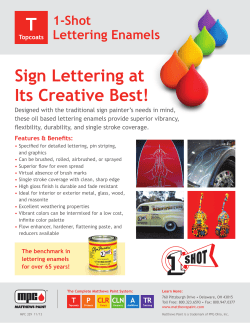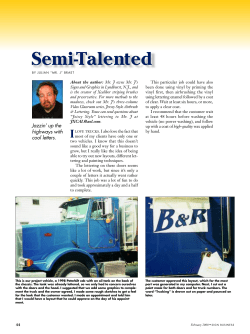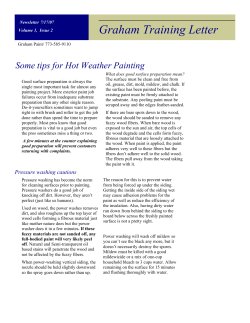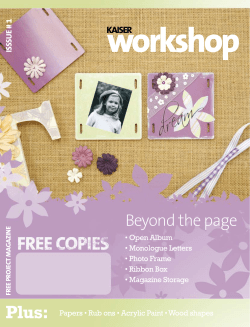
Eleven sign makers discuss the paints they used
Eleven sign makers discuss the paints they used on a variety of projects ■ Prep is important on any surface. It should be clean and free of contaminants that might prevent proper adhesion. Never assume that a surface is clean enough to paint unless you’ve cleaned it. Choosing the right paint for the job Plywood. Aluminum. PVC. Acrylic sheet. Acrylic fabric. Stucco. Vinyl. Glass. Urethane. Wood. Steel. Fiberglass. Does any other business require that you know how to properly paint so many different materials? As a sign maker, you never really know what material you’ll be working on next. There is, of course, no one paint Gary Anderson, Bloomington Design, Bloomington, Indiana: “This sign has a high-density urethane background with a double stage blast (which creates multiple levels) and add-on high-density urethane hand-carved letters. We don’t prime HDU since primers traditionally dry more slowly than finish coats. HDU doesn’t absorb anything so moisture in the Porter 515 Acrylic Primer must evaporate 40 July / August 1999 ■ Read the directions. And read the tech sheets on the product if they are available. Manufacturers want you to use their products successfully (so that you’ll use more) and usually provide plenty of guidance to help you. you can use successfully on all these surfaces. Each puts different demands on a coating. It’s the responsibility of the sign maker to know what works and where. Nothing reflects as badly on a sign shop as materials that fail prematurely. When paint (or vinyl) is peeling before its time, it casts a doubt about the competence of Sandblasted urethane the sign maker. That’s why it is so important to choose the right coating for the task, and to apply it properly. Here are some pointers that can keep you out of trouble: ■ When in doubt, ask for help. Before you use a coating in an application that you are unsure that it was designed for, call your supplier or the manufacturer. One quick call can help you avoid disaster. Here’s a sampling of great-looking sign work with the comments of the sign maker on the paints they used. On page 48, you’ll find a handy source list that will help you contact manufacturers and locate products. rather than be absorbed. “Primers are more of a fill coat and are probably necessary if you finish with enamel. We use acrylic latex for all of our finishes, and they fill the pores in HDU very well. We are currently experimenting with Jay Cooke’s and Precision Board’s water-based primers, though. “We sand all materials smooth and slightly round all square corners. Paint stays on the corners better when it can bend around the corner rather than a quick 90degree turn. We coat the entire sign (front and back) with two to three coats of the finish acrylic background color. We follow with two coats of acrylic on the lettering and borders with a light sanding between coats. “We use Porter 500 series flat acrylic house paint for this entire process. It is applied with bristle fitches and smoothed on the flat surfaces with a roller with a 3/8-in. nap. We use flats and quill-type brushes to letter, outline, stripe, to paint centers and pictorials. Andrew Mack and Sons Brush Co. [P.O. Box 157, Jonesville, MI 49250; 517849-9272] makes a full line of brushes for water-based paints. If there are areas to be gilded, we apply an extra coat or two of paint to these areas, then apply a final coat over the entire sign. This only takes a few minutes and gives an excellent finish for gilding.” Overlaid plywood sign Overlaid plywood sign Todd Hanson, Hanson Graphix, Wauseon, Ohio: “For signs like this, I start with raw overlaid plywood. I prime with Ronan Block-Out White or Chromatic Metal and Wood Primer. I follow that with two coats of finish enamel and they hold up great—five to eight years, depending on the exposure and the colors. I avoid thinning my paints any more than is absolutely necessary, too. It gives you a thicker film of paint on the surface.” Larry Hansen, Lettermen/Signage Mokena, Illinois: “Most of our work is commercial/industrial real estate signs. For these, we use pre-primed 1 /2-in. overlaid plywood. It is sold as ‘good one side’, but the back is laminated with the same laminate used on the good face to help make the sheet more stable. The primer appears to be sprayed on the faces and edges, and is very smooth. We can’t afford the time it takes to apply a primer in-house and let it dry—that adds an extra day to the process. “We roll a coat of black acrylic latex solid-hide exterior stain on the back, turn them over, then roll on one coat of Ronan Finish White enamel. The sheet is ready to use the next morning. We use the same black exterior stain on our pressuretreated posts. “We’d like to see a five-year life from these, but that’s in the best case. We get these back from our customers to reletter from time to time, so we get to see the effects of the weather close up. They usually hold up well for three years or so. “You’ll notice some minor deflection in the upper left-hand corner of these panels. Stringers would obviously eliminate this problem; the cost made that unacceptable.” Turn to page 42 Carved redwood sign Howard Bertram, Paramount Promotions, Cave Creek, Arizona: “On these signs, I primed with two coats of a high-quality oil-based primer, like Benjamin Moore. I thinned the first coat quite a bit; the second coat was closer to full strength. For a finish coat, I’ve used both lettering and bulletin enamels with good results. The little pictorials are also done in lettering enamels.” SignCraft Magazine 41 Choosing the right paint for the job Window lettering Face for illuminated sign Chris Shuster, Son Signs, Yankeetown, Florida: I used the router as a plotter to cut mask for these 3-by-5-ft. illuminated sign faces. Then I weeded them and back-sprayed them with Akzo’s Grip Flex translucent paint. Todd Hanson, Hanson Graphix, Wauseon, Ohio: “I always start by cleaning the glass very thoroughly with Windex window cleaner. This lettering was done on the inside of the glass with One Shot enamels. It was close to the shop, so I let each color dry thoroughly before going over it with the next one. I explained that they should not wash the window if it is steamed up, as sometimes happens in the winter.” Vinyl banner Bob Stanton, Mr. Sign, Milford, Connecticut: “We often coat out all or part of a vinyl banner to get away from that ‘plain white banner’ look. The Hair*Skin*Nails banner was coated out completely with one coat of purple Deka Sign Enamel. The copy is all done in vinyl. On Saint Mary’s Carnival, we started with a black vinyl banner, then painted the red panel. We put down a coat of white Deka Sign Enamel first to improve the coverage of the red. The copy is all done with vinyl.” Turn to page 44 42 September / October 1995 Choosing the right paint for the job Acrylic fabric awning Overlaid plywood sign Gary Anderson, Bloomington Design, Bloomington, Indiana: “This sign is 3 /4-in. overlaid plywood on cedar poles with vinyl and hand lettering. We sand the edges, corners and surface with 120-grit sandpaper. Don’t sand the edges too smooth or the paint may lift and fail prematurely. Acrylic paints do allow some of the moisture through, which adds a bit of security. “Bare wood makes it necessary to use a primer, so we use one coat of Porter 515 primer. This is then sanded and two finish coats of Porter Series 600 gloss acrylic house paint is applied with a 3/8-in. nap roller, with a light sanding between coats. We use gloss on overlaid plywood because it looks more traditional and to facilitate vinyl adhesion, though we have no problem with vinyl on flat paint. On single-faced signs, we coat the back of the sign, too. Detailing is done the same as on our sandblasted signs.” 44 September / October 1995 Chris Shuster, Son Signs, Yankeetown, Florida: “For awnings like this, I cut a mask from high-performance vinyl and apply it. High-performance vinyl conforms best to irregular surfaces. To make removal of the application tape easier, dampen it, then remove carefully. I heat the vinyl with a hair dryer and press it down firmly to minimize paint bleeding under the mask. Then I roll on a base coat of top quality acrylic house paint that is the same color as the background. This base coat will bleed slightly under the mask, but it will not be noticeable since it’s the same color as the awning. Then I follow with three coats of the finish color. At this point, if the design allows, a fade or texture can be quickly achieved with a roller or spray gun. Give your customer this option to increase your profit and enhance their image as well.” Pinstriping and vehicle graphics John Hannukaine, Hannukaine Signs and Graphics, Tumwater, Washington: “I begin by cleaning the area that gets the graphics with Super-Solv (Crest Industries, Inc., Wyandotte, MI 48192; 313-283-4100). I squirt plenty of it on a couple of heavy lint-free paper towels, wash the area down and wipe it dry with a clean paper towel. Don’t let it evaporate away—wipe it off. I repeat the process, then the surface is clean. It’s never let me down in three years. It’s a strong solvent, so I put two rubber gloves on the hand that applies it. On a plastic bike or car, I wipe once lightly with denatured alcohol to eliminate the static electricity. “I paint with One-Shot enamels, usually thinned with mineral spirits. What you thin with depends on your climate. One Shot makes several thinners that are designed to work with their paints that you would want to experiment with. I add a couple of drops of Fish Eye Eliminator, too. It’s available from auto paint suppliers.” Wall sign Casper Cox, Prizma, Chattanooga, Tennessee: “This wall was painted with a semi-gloss acrylic latex paint. I did all the lettering and graphics with One-Shot lettering enamels. Coverage is always good with lettering enamel, the colors are bright and they’re very durable. When it comes to paints and coat-out, I don’t deviate much from what I know works. I avoid panels that the customer coated— that can lead to real headaches.” Sandblasted redwood Gary Anderson, Bloomington Design, Bloomington, Indiana: “As on all painted panels, we ease the corners with sandpaper before finishing. Bare wood needs a coat of primer to start with, so we use Porter 515 acrylic primer. One coat is adequate as acrylic seals very well. This is then sanded and two finish coats of Porter Series 500 flat acrylic house paint is applied with a brush and a 3/8-in. nap roller, with a light sanding between coats. On wood, the drying times are much faster than on high-density urethane. It can be recoated in about two hours. This sign is installed on pressure-treated posts. Acrylic primer and paint works well on them because acrylic allows moisture to leave the poles without pushing the paint off.” Polyester stucco, high-density urethane, PVC, Fiberbrite, and more Chris Shuster, Son Signs, Yankeetown, Florida: “This sign has a foam core background that was fabricated by Peachtree City Foamcraft [P. O. Box 3138, Peachtree City, GA 30269; 877-862-0840] from my design. It was designed to slide down onto the steel posts. It is made from polystyrene foam with a durable plastic hardcoat and synthetic stucco finish. The background was then painted with acrylic house paint. The magnolias, letters and the Furniture Gallery panel are Sign•Foam [Sign•Arts Products, 34085 Pacific Coast Hwy., #205, Dana Point, 92629, 800-338-4030] high-density urethane sprayed with a catalyzed primer, paint and then clear coat, all from Matthews Paint Company. “When the budget allows, we use catalyzed urethane paint systems, like Matthews. We get excellent durability with them. Usually we spray it, but there is a brushing catalyst available. On dimensional signs, I use an acrylic house paint on the background because we want a flat finish. Then we brush a couple coats of catalyzed paint on the copy. With the computer-driven router, we often cut the lettering from PVC or acrylic sheet, paint them, then adhere them to the sign. “Letters and panel are HDU. The magnolia was hand carved in HDU then cast because I had to make several of them. The outline on the main copy and inlaid letters on the panel were router cut from Fiberbrite [US Highway Products, 114 Porter St., Waterbury, CT 06708; 800-883-8363]. The main copy has a gilded, beveled edge, a sprayed blend on the face, and are clear coated.” Turn to page 46 SignCraft Magazine 45 Choosing the right paint for the job Airbrushed vinyl graphics Sandblasted redwood Marvin Renter, MR Graphics, Norfolk Nebraska: “I do a lot of airbrushing on vinyl film, especially for semis. I spray on Createx Auto-Air Sign & Auto Airbrush Paint then follow with a coat of Frog Juice [Far From Normal Supply, PO Box 790, Fargo, ND 58107; 800-877-1907]. I’ve been using this method for over two years, and everything still looks great. Trucks get a lot of abuse, too. I’m discovering how often these rigs change hands or the drivers switch companies within that length of time. Many of these graphics get changed within two years.” Nancy Beaudette and Noëlla Cotnam, Sign-It, Cornwall, Ontario, Canada: “On blasted signs, we start with one really good coat of Jay Cooke’s All-Purpose Sign Primer [HAR Adhesives & Coatings]. Most of our backgrounds are medium to dark colors, so we tint the primer gray. We follow with at least two coats of a quality acrylic latex. We like the contrast between the flat finish on the background and gloss on the lettering, so we use lettering enamels for the lettering, graphics and pictorials. “On a flat painted signs, we use two coats of Jay’s primer. It’s a full-bodied, waterbased primer. We finish flat signs with two coats of sign enamel.” Sandblasted redwood and high-density urethane Lois and Jim Schmidt, Schmidt’s Signery, Hamilton, Ohio: “On both redwood and high-density urethane, we start by brushing on two coats of Porter 515 Bonding Primer. Then we follow with up to three coats of Porter’s top-grade high gloss acrylic for finish. If we are gilding copy, we apply our slow size to the acrylic, then gild. When painting the copy with gloss acrylic latex, I prefer a sable, but most of the people in our shop prefer a foam brush. We have several signs up for seven years that still look fine.” 46 July / August 1999 Truck lettering Todd Hanson, Hanson Graphix, Wauseon, Ohio: “If the truck has been waxed, I begin by cleaning with cleaner used for auto paint work, like Dupont Wax and Silicone Remover, following the instructions on the can. Then I clean it with Windex window cleaner a couple times. If it’s never been waxed, I just clean it two or three times with Windex. “This truck was done with One Shot lettering enamel and One Shot thinners. I think it’s best to use the thinners that are designed for the paint—just as the big auto paint companies recommend. “I don’t have many problems, outside of the occasional person who pressure-washes his lettering the day after I did it. I’ve got trucks out there for five or ten years, but they’ve been cared for using common sense.” Turn to page 48 SignCraft Magazine 47 Choosing the right paint for the job Airbrushed truck lettering Bert Quimby, Bert Graphix, Riverdale, New Jersey: “I start by cleaning the area to be lettered with Windex window cleaner. Then I clean it with 3M Adhesive Remover, which takes off any residue on the surface. After that, it gets another cleaning with Windex. “When I paint directly on the vehicle, I use lettering enamel. Over the past year or so, I’ve been doing more of my custom work on vinyl because it lets me get the job done faster. On vinyl, I use House of Color [Valspar Refin- ish] urethanes then clear with Frog Juice. They have some great pearl colors, and the super fast drying time speeds up production. An airbrush job that takes five hours in enamels takes about half that time to do in urethane. “On Paradise Landscaping, I started with white vinyl and instead of a conventional bevel, used House of Color Pearl White Silver urethane. Using a hand-held shield, I airbrushed the bevel on the letters. When you look at it from an angle, the silver changes colors and it really looks three-D.”❑ Source list: Paints and coatings Akzo Nobel Coatings, Inc. 5555 Spalding Dr. Norcross, GA 30092 770-662-8464 Fax: 770-662-8620 www.signfinishes.com Chromatic oil-based and waterborne primers, paints and additives Coastal Enterprises Co. P.O.Box 4875 Orange, CA 92863 714-771-4969 800-845-0745 Fax: 714-771-6422 www.precisionboard.com Precision Board primers/fillers, texture coatings and crack repair Createx Colors 14 Airport Park Road East Granby, CT 06026 860-653-5505 800-243-2712 Fax: 860-653-0643 Createx Auto Air waterbased acrylic airbrush colors 48 September / October 1995 Decart P.O. Box 309 Morrisville, VT 05661 802-888-4217 800-532-7895 Fax: 802-888-4123 www.dekapaint@pwshift. com Deka waterbased coatings Fine Paints of Europe P.O. Box 419 Route 4 West Woodstock, VT 05091 802-457-2468 800-332-1556 Fax: 802-457-3984 www.fine-paints.com Schreuder oil-based and waterborne primers, paints and clears HAR Adhesives & Coatings 4300 Payne Ave. Cleveland, OH 44103 216-391-1255 Fax: 216-391-1266 haraac@en.com Jay Cooke’s All-Purpose Sign Primer Matthews Paint Company 8201-100th Street Pleasant Prairie, WI 53158 414-947-0700 800-323-6593 Fax: 414-947-0444 www.signpaint.com Matthews acrylic polyurethane paints and primers One Shot, LLC P.O. Box 6369 Gary, IN 46406 219-949-1684 Fax: 219-949-1612 www.1shot.com One Shot oil-based and waterborne primers, paints, clear and additives Rich Art Color Co. P.O. Box 198 Northvale, NJ 07647 201-767-0009 Fax: 201-767-0567 Rich Art Window & Glass Paint; Rich Art Moist Watercolors Sign Life Systems 162 Diamond St. Mansfield, OH 44902 419-524-7446 Fax: 419-524-7446 1st STEP Primer and Sign Life stains Spraylat Corporation 716 S. Columbus Ave. Mt. Vernon, NY 10550 914-699-3030 Fax: 914-699-3035 www.spraylat.com Spraylat acrylic urethane paints TJ Ronan Paint Corp. 749 E. 135th St. Bronx, NY 10454 718-292-1100 800-247-6626 Fax: 718-292-0406 Ronan oil-based and waterborne primers, paints and clears Valspar Refinish 210 Crosby St. Picayune, MS 39466 800-844-4130 Fax: 601-798-6147 www.houseofkolor.com House of Kolor urethane, polyurethane, and lacquer paints Professional quality exterior acrylic latex paint manufacturers: Benjamin Moore & Co. 51 Chestnut Ridge Rd. Montvale, NJ 07465 800-826-2623 www.benjaminmoore.com MAB Paints M.A. Bruder & Sons 600 Reed Rd. Broomall, PA 19008 800-622-1899 www.mabpaints.com Porter Paints 400 South 13th St. Louisville, KY 40203 800-332-6270 www.porterpaints.com SignCraft tries to make sure all source lists are complete, but occasional omissions are inevitable. If your company or other source was omitted from this or any other list, please let us know. We’ll update readers in a following issue.—Editors
© Copyright 2025


















